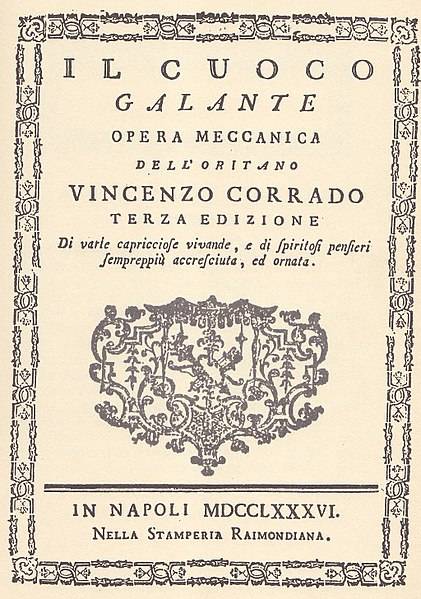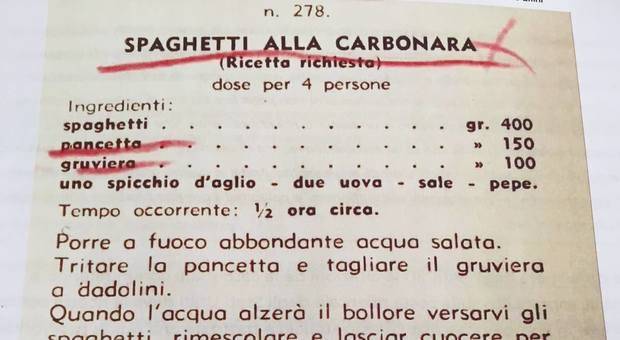The origin of carbonara is quite recent: no mythological predecessors, no lamentable peasant civilization to mourn, no 100% Italian DNA. Truth be told, the birth of carbonara isn’t entirely credited to the great Italian culinary tradition. It has much more to do with American bacon and Gruyère cheese. But let’s take it step by step before some of our readers have a fit.
Ancestors of Carbonara

In Italy, the love for cooking is part of the cultural heritage, which has led to the flourishing of chairs of culinary history in the best universities, accompanied by fascinating research that has debunked myths believed to be millennia-old. Carbonara’s story is just one of the most difficult to dispel because, as everyone knows, there are only two things you can’t speak ill of in Italy: mama and food.
Carbonara, in particular, seems to have ancestors in similar recipes, but hardly comparable. In Neapolitan cuisine, for example, eggs have been used to thicken soups and pasta in broth since the 1700s, as demonstrated by recipe books of the time written by Vincenzo Corrado (“Il cuoco galante,” 1773) and Ippolito Cavalcanti (“Cucina teorico-pratica,” 1847).
In 1881, another Neapolitan cook, Francesco Palma, published the recipe for “maccheroni with cheese and eggs,” but no pancetta or guanciale. In 1949, the journalist Ada Boni published a cookbook of Roman cuisine with the recipe for spaghetti with guanciale, but no eggs in this case.
The original is Made in the USA
The first recipe bearing the name carbonara was published by Patricia Bronté in a Chicago restaurant guide in 1952. It seems that the carbonara as we know it was offered by the restaurant “Armando’s” to its customers in the American city.
And the first recipe published in Italy? It dates back to 1954 and was published in the magazine “La Cucina Italiana” but frankly, it doesn’t resemble much the one we all imagine. The ingredients were: spaghetti, egg, bacon, Gruyère cheese, and garlic. Stuff for heart attacks for purists of Italian cuisine.

The following year, in “La signora in cucina” by Felix Dessì, a recipe more similar to the contemporary one can be found, but still no guanciale, and instead of Gruyère, Parmesan or pecorino cheese was equally accepted.
The birth and evolution of the recipe
But why is carbonara so tied to Roman cuisine? It is plausible that the American ancestor of carbonara arrived in Rome along with the American army that liberated the city in 1944. During the period beautifully depicted in Neorealism films (Rome, Open City, Roberto Rossellini, 1945), American troops might have brought along foods that were scarce in Italy at that time: eggs and bacon.
The most accredited hypothesis is that in 1944 Renato Gualandi, a young Bolognese cook, was hired to prepare a lunch for the meeting between the British and American corps that took place in Riccione, recently liberated from Nazi occupation. On that historic occasion, Gualandi prepared a carbonara avant la lettre that was greatly appreciated by the Americans.
It is known about Gualandi that he would later become the official cook for the American troops stationed in Rome until 1945. This was enough to tie the destiny of this dish to Roman cuisine.

What about the guanciale? The first recipe to include it is from 1960 by Luigi Carnacina, who also added cream. This last ingredient would also be a protagonist in the version by the great Gualtiero Marchesi, who, as the father of modern Italian cuisine, added a quarter liter for 400g of spaghetti in 1989.
There are versions with wine, garlic, onion, parsley, bell pepper, and chili pepper. It was after the 1990s that its evolution crystallized, and carbonara became that untouchable icon that today even has its own celebration: Carbonara Day.
What to pair with carbonara

The truth is that carbonara, like any dish from all over the world, cannot have a way or a recipe that remains unchanged over time. As we have seen, the tastes of the people who have eaten and cooked carbonara have changed within a few years, and even today, different versions are invented.
There is seafood carbonara, of course, but also vegetarian and even vegan ones. So we accept the challenge and give you a pairing for each carbonara.
Traditional Carbonara
In traditional carbonara, eggs and guanciale are the protagonists. We recommend pairing it with a classic Trentino method like Trento Brut Nature di Balter.
Seafood Carbonara
This version of the recipe keeps the egg but replaces the guanciale with fish, particularly tuna, salmon, or swordfish sautéed in a pan. In this case, the wine we recommend is Friuli Isonzo Cuvée Flors di Uis 2017 by Vie di Romans.

Vegetarian Carbonara
There are a thousand variations of this recipe, but the most accredited one online uses zucchini, which with the egg make a perfect match. Here, onion and experimentation with seasonal vegetables are absolutely allowed. Since we have already stoned tradition, we can lightly pair it with a rosé sparkling wine: Faive Spumante Rosé Brut by Nino Franco.
Vegan Carbonara
Here we are on the verge of blasphemy for purist friends, but we at xtraWine are for inclusion and think of all of you. In these versions, this recipe obviously excludes eggs, and you have no idea of the number of possibilities that exist to replace even the guanciale: soy, tofu, seitan, tempeh, vegetables. So our pairing will take into account the dietary choices of those who might consume this dish, and we choose a vegan white: Sauvignon Blanc Turranio 2023 by Bosco del Merlo.














